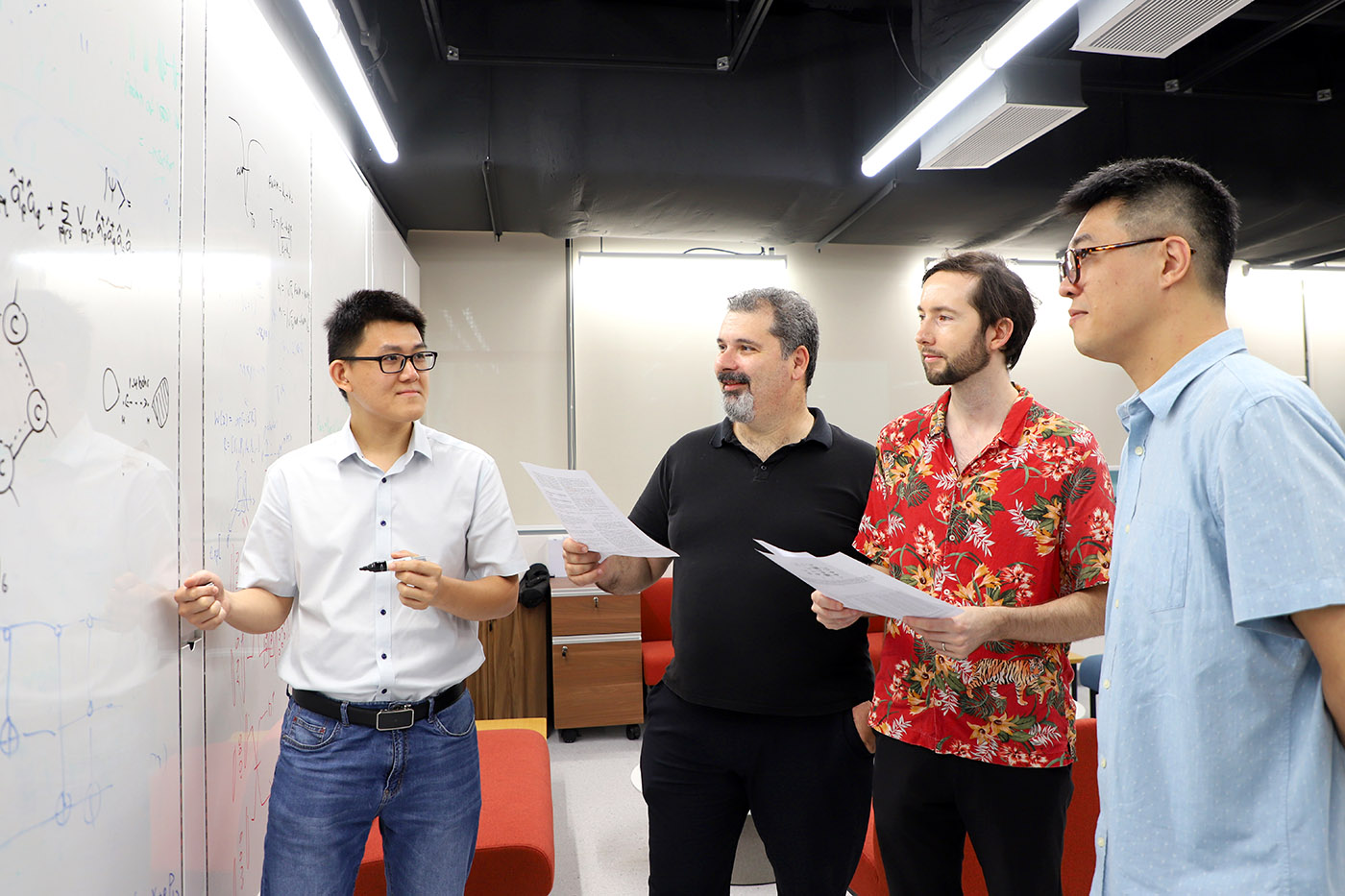Highlights
Algorithm calculates bond energies for quantum chemistry
 (From left) Co-authors Chee Chong Hian, Dimitris Angelakis, Daniel Leykam and Adrian Mak. With Panagiotis Barkoutsos, they have demonstrated how quantum computers could be useful in calculating the energy between electrons in a molecule.
(From left) Co-authors Chee Chong Hian, Dimitris Angelakis, Daniel Leykam and Adrian Mak. With Panagiotis Barkoutsos, they have demonstrated how quantum computers could be useful in calculating the energy between electrons in a molecule.
Quantum computers are touted for application in the development of materials and drug discovery, resting on the idea they can better calculate properties such as bond energies. Researchers from the Centre for Quantum Technologies (CQT), A*STAR’s Institute of High Performance Computing (IHPC) and IBM Quantum have shown that even noisy intermediate-scale quantum (NISQ) computers can do this work.
Their paper was published in Quantum Science and Technology on 29 January 2024.
The interactions between electrons and nuclei lie at the foundation of chemistry. Knowledge of the energy that binds them as atoms and molecules helps researchers understand chemical reactions and the key features of molecular structure and properties.
However, it is challenging to compute the interaction energy between electrons and nuclei in a molecule quantum mechanically. Aside from the electron-nuclei and nuclei-nuclei interactions, the electron-electron interactions are complicated and include electronic correlations, which typically constitute roughly 1% of a molecule’s total energy. However small, they can result in the manifestation of physical phenomena. For example, describing how helium liquefies at certain temperatures would not be possible without accounting for electron correlation.
Here’s where the team’s new quantum algorithm can help. CQT PhD student Chee Chong Hian, who is the first author of the paper, says, “While there are other quantum algorithms to calculate the electronic correlation energy, ours is the only NISQ algorithm so far that does so using the framework provided by perturbation theory.”
Chee’s co-authors are Adrian Mak, Principal Scientist from A*STAR’s IHPC; CQT Senior Research Fellow Daniel Leykam; Panagiotis Barkoutsos, formerly at IBM Quantum; and CQT Principal Investigator Dimitris Angelakis. Dimitris is also Associate Professor at the School of Electronic and Computer Engineering, Technical University of Crete. The work comes under the project “Resource efficient quantum algorithms and applications for chemistry, route optimization and finance”, which is funded by Singapore’s Quantum Engineering Programme.
Estimating the 1%
Computing electronic correlation energy means accounting for the electrons being scattered by their interactions into excited states.
“The number of such configurations scale steeply with increasing number of electrons and increasing number of excited states possible for each electron,” says Adrian. Doing this calculation directly would need deep circuits that take longer times than the lifespans of qubits on current NISQ computers. To make their algorithm friendly to NISQ computers, the researchers developed an estimation technique that builds on existing methods.
In 2020, a team from Google estimated the bond energy by preparing and measuring ‘Hartree-Fock’ states. These states are molecular energy configuration states that treat electronic interactions in an averaged manner. It serves as a starting point to recover electronic correlation energy.
In their new work, the CQT researchers and their collaborators have identified that a quantum superposition of Hartree-Fock states can estimate electronic correlation energy. The intuition is that the electronic interactions create a superposition of the Hartree-Fock states.
The researchers consider the superposition of the ground and excited Hartree-Fock states. The calculation of electronic correlation energy from their method takes shallow linear-depth circuits which can be implemented on NISQ devices without significant compromise on accuracy.
Benchmarking on NISQ devices
The researchers tested this quantum algorithm for four small molecules, H2, H3+, LiH and H4. They used up to 8 qubits to model the molecules, trying out three different quantum processors: the superconducting 27-qubit IBM-Auckland, the superconducting 5-qubit IBM-Lima and the trapped-ion 11-qubit IonQ. The processors were accessed via quantum cloud providers IBMQ and Amazon Braket.
The team found comparable performance across the three quantum processors and good agreement with results from classical simulations of their algorithm in the absence of noise. This suggests the algorithm is working as intended in the NISQ computers.
The researchers plan to extend their work on bigger molecules such as benzene and study quantum dynamics. “Chemistry is a hard problem for classical computers because it is quantum in nature. It has attracted a lot of attention, including our group’s. Adrian, as a quantum chemist, is a natural fit to collaborate with,” says Dimitris.
Learn more
Related Stories
 | Finding quantum advantage for analogue systems April 10 2023 |
 | CQT researchers awarded grants under Singapore’s Quantum Engineering Programme April 21 2022 |






